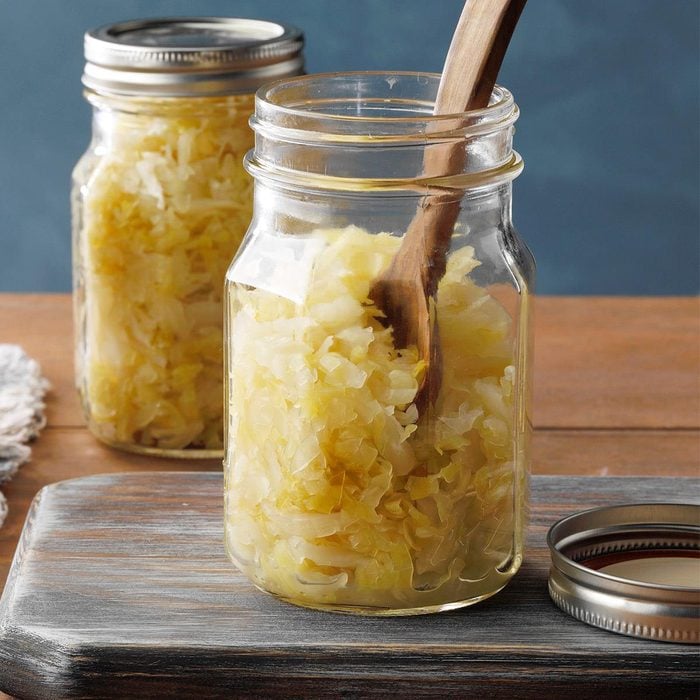While it might not be the first ingredient on your grocery list, sauerkraut plays a big role as a delicious ingredient and condiment. A Reuben wouldn’t be the same without it, and neither would grilled bratwurst. Because sauerkraut plays such a major part of our go-to comfort foods and German dishes, it’s worth learning to make sauerkraut yourself. You’ll get to take pride in learning how to ferment and get to customize the flavor.
Sauerkraut Ingredients
- Cabbage
- Canning salt
- Optional: Granny Smith apples, sweet onions, caraway seeds and ground coriander
Directions
Step 1: Core and slice cabbage

To start, quarter the cabbage and remove the cores. Then slice the cabbage thinly (1/8-inch thick is perfect). Work slowly and carefully—it’s a lot of chopping! If all this slicing seems daunting, you can use a mandoline slicer to make uniform cuts more quickly.
Once you’re done, pop the sliced cabbage into a large bowl and mix with the canning salt. Let the cabbage sit until it starts to wilt and release liquid—about 10 minutes.
Test Kitchen Tip: Be sure to use canning or pickling salt here. This coarse salt doesn’t have any additional ingredients or anti-caking agents that interfere with the recipe. A large box costs about two dollars, so grab one and use it for many batches of sauerkraut and pickles to come.
Step 2: Squeeze, squeeze and squeeze

After letting cabbage rest with the salt, it’s time to squeeze. Squeezing all this cabbage has several benefits. First, it helps release the liquid from the veggie. It also helps work salt thoroughly into the mixture and softens the cabbage up even more so you get that just-right sauerkraut texture.
This is also the most laborious part of the process. You really want to squeeze, squeeze, squeeze to get every bit of liquid out of the cabbage. When you think you’re done, give the cabbage another squeeze.
This process should take about 10 minutes, so don’t rush!
Step 3: Prep extras
To make traditional sauerkraut, all you need is cabbage and salt. However, if you want to amp up the flavor a bit, you can add additional ingredients. We recommend apple, onion and caraway. If you prefer a little heat, add some crushed red pepper.
To prep, peel, core and thinly slice the apples. Thinly slice the onion, too. Then toss the apple, onion and caraway seeds with the squeezed cabbage.
Step 4: Pack cabbage into a crock
Next, firmly pack your cabbage mixture (liquid included) into a fermenting crock or glass fermenting container, removing as many air bubbles as possible. Use a pickle packer or wooden tamper to help you along the way.
Ideally, the cabbage mix should be covered by one to two inches of liquid. If you find that there isn’t enough in your container, make a brine to compensate. This is super simple: Combine four-and-a-half teaspoons of canning salt and a quart of water in a saucepan. Bring to a boil until the salt is dissolved. Cool and add to the croc, covering the cabbage by two inches.
Step 5: Weigh it down

After that, you’ll want to weigh the cabbage down. If you’re using an old-fashioned crock, place a dinner plate or pie plate over the cabbage. The plate should be slightly smaller than the container opening, but large enough to cover most of the shredded cabbage mixture. You can weigh this down with heavy jars filled with water.
If you have a fermentation kit, it’ll typically come with weights. Press the weights down over the cabbage (the weight should be submerged in the brine) and screw on the top. Follow the guidelines included with your kit.
Step 6: Wait
After getting your crock of cabbage all set, all that’s left to do is wait. Store the crock in a 70 to 75ºF room for three to four weeks.
Check the container a few times a week to ensure that the cabbage is submerged. Also, skim away any scum that may form on top of the liquid. This sounds gross, but this is a totally normal part of the process. Just scoop any foam off with a spoon.
Throughout the process, the scent will change—again, this is all part of the fermentation process.
You’ll know that your cabbage is officially sauerkraut (and the fermenting is complete) when the bubbling has stopped. Once fully fermented, transfer the sauerkraut into containers and stash in the fridge for up to three months.
Sauerkraut Tips
How do you store sauerkraut?
While you’re making sauerkraut, store your crock or jar somewhere between 70 and 75ºF. A corner of the kitchen counter works fine, so does the pantry. You want it out of the way enough so no one bumps the container, but accessible enough to check on it every few days.
Once the sauerkraut is fermented and it’s ready to eat, you can pop it into glass jars or airtight containers and keep it in the fridge. You should eat it within three months. If you’re not a regular sauerkraut eater, you might want to consider giving a few jars away since this does make a fairly large batch.
How do you serve sauerkraut?

Sauerkraut is, of course, delicious served up with sausages or with corned beef (especially for Reubens). But you don’t need to stop there! Add sauerkraut to skillet dinners with potatoes, onions and bacon. It gives simple ingredients a bit of personality. Even dessert! Add some to this delicious chocolate cake with sauerkraut (really!).
















